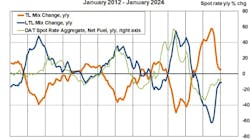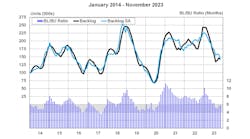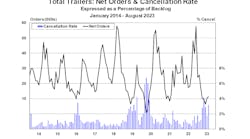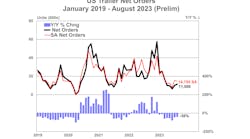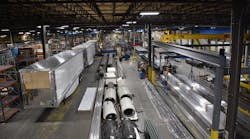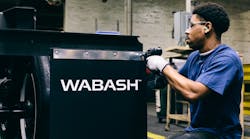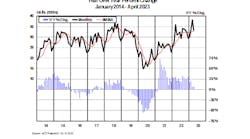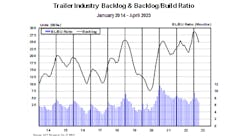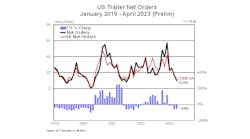Eric Starks thinks it will, and has adjusted his forecast upward from 264,000 because of pressure
he sees in the system
At last year’s FTR Transportation Conference, FTR chairman/COO Eric Starks presented a Class 8 forecast that called for 231,000 units in 2017 and 264,000 in 2018.
As 2017 progressed, Starks downgraded his forecast to as low as 210,000, then settled on 247,000. And his 2018 forecast is now for 300,000—a 13.6% increase over what he saw a year ago.
“We’re seeing a lot of pressure in the system that helps us feel more comfortable about the direction of where that mark is going,” he said.
Giving his annual presentation, “Commercial Vehicle Class 8 Equipment Outlook: The FTR Perspective,” Starks said things have changed in his backlog analysis.
“We found that by the end of July, all of them were basically built,” he said. “We have not seen that in a long time. This suggests people are pushing for deliveries in the short term rather than looking at the longer term. Typically when that happens, it suggests there’s pressure in the system to say, ‘I need a truck today rather than tomorrow.’ That is a welcome sign and something we have not seen over the last several years.”
FTR’s forecast for Q3 Class 8 North American builds was 69,500, but OEM plans were for 71,700. For the fourth quarter, FTR’s forecast is for 64,500 as opposed to OEM plans for 63,000.
“So they’re pretty much offsetting,” he said. “We are more than happy to tell you what we think. We do not look at the build plans first. We basically put our forecast together and then look at the build plans to say, ‘OK, is there a disconnect? If there is a noticeable difference, we need to understand why. Is there is something that is materially there where we need to make an adjustment?’ ”
He said when he looks at quarterly Class 8 production, he is encouraged by the surge in Q2 to 63,000, and that has given him the confidence to forecast 69,000 for Q3 and then a normal seasonal decline in Q4 to 65,000. He sees a quarterly breakdown in 2018 of 70,000 and 78,000 in the first two quarters—well above last year’s figures of 63,000 in each quarter—and then 77,000 and 75,000 to finish the year.
“We are nowhere up to the levels we saw in 2014,” he said, referring to totals of 78,000 in each of the last two quarters, “but we are still at relatively healthy levels going forward.”
While Starks projects 285,000 for 2019, followed by 279,000 in 2020 and 281,000 for 2021, he thinks the market will continue to be defined by volatility.
“We won’t likely see a 2009 type of event unless we have an economy that just implodes,” he said. “But those up-and-down rollercoasters are clearly going to be there. We basically are saying, ‘OK, we feel like we have good visibility out for two years.’ Beyond two years, we get to a point where, how do you forecast the economy? How many of you can forecast a recession two years out? It can’t happen. It’s virtually impossible.
“We have trend growth for what we think the growth environment will look like for the economy. We think it’s going to be 2.5% to 2.7%. From there, you’re putting your forecast together off of that. We are not doing a business cycle forecast. This is an economic forecast off of the trend beyond two years. We do it this way because if we start trying to guess when that’s going to happen, then we would be giving you bad numbers.”
One of the wildcards is the electronic logging device (ELD) final rule, which has a compliance date of December 18.
“In essence, our forecast right now is a no-regulation forecast,” he said. “So if the regulations do become a noticeable problem and productivity drops further, you will need more equipment into the marketplace. The problem we run into is, what do you do with the drivers? That becomes a huge issue. How do you put a driver in that truck? At the same time, if there is freight to be moved and you need equipment to move that freight, you find that driver. I’m not saying it’s cheap or easy. It’s not.”
Starks provided a quick look at the goods-producing sectors of the economy:
• ISM Manufacturing Index.
“The data is now telling us that we actually are starting to see growth in this sector and the numbers are looking pretty good. It’s sitting close to 59. Anytime you get to 60 and above, that is a very healthy market.”
• Core capital goods orders.
“The area I’m most concerned with is what’s happening within the business environment. Are businesses willing to spend? A great way is to look at core capital goods orders. In September 2014, it hit a high level and then started to drop off from there. It came down, down, and finally hit a bottom. It started to pick up. We thought, ‘Is this a head fake? Are they actually starting to buy?’ At the same time, we had the election and all these things happening, and the stock market went up. If the stock market goes up, do businesses automatically spend money? No. They have nothing to do with each other. The stock market is basically saying, ‘Here’s what we think our revenue expectations are going to be from an ownership perspective of how we value the stock.’ We have to divorce those two a little bit. We found they have started to clearly show an upward trend in saying, ‘We’re willing to spend some money.’ From my standpoint, there is a substantial amount of upside pressure from a positive standpoint. I don’t anticipate it will turn and head straight up, but I do anticipate this type of slow recovery to continue to happen.”
• Business inventory/sales ratio.
“If you have too much inventory, do you buy more goods? Typically, no. There would really be no reason to do that. So the easy way to look at this is look at the inventory-to-sales ratio. The higher that number is, the less you need to buy because you already have it in stock. This is a great pressure gauge for the commercial vehicle and freight markets. We got back to levels we really hadn’t seen since the Great Recession. We’ve seen it coming back down, but not to levels that would make me feel warm and fuzzy and say, ‘Hey, things are going to go crazy because everybody’s out of inventory.’
“We’re trying to understand, ‘Why are they willing to hold onto more inventory and what does that balance look like?’ Part of the reason they are holding onto more inventory is the cost of capital. If money is basically free, do you care if it’s in cash or if it’s in inventory? Typically, no. So holding onto inventory is not a big deal right now. But as that cost of capital goes up, you have that opportunity cost and you go, ‘Why am I holding this in inventory? I should be holding this in cash.’ We haven’t seen that transition yet.
“As we start to see interest rates going up, that creates upward pressure and the number should slowly start coming down. As we start seeing a shift to things more like Omnichannel and competition with Amazon, people will be looking at the business structure. What does the brick-and-mortar environment look like? Do they need to be holding onto more inventory? If they are changing their business models and saying, ‘We want to get closer to other businesses and the consumer,’ are we starting to see a fundamental shift where they are willing to hold onto to more inventory? All we can do is look at data and try to make sense of it.”
• Existing home sales inventory.
“There are two aspects: new construction and existing-home sales. If you don’t have a lot of existing homes available to be purchased, what do you do? You raise the price of that existing home. And/or you then go out and start to build. They are actually selling a lot of existing homes. The price of those existing homes continues to go up. So the likelihood that we start seeing a shift to more new builds starts to increase. With what happening with the storms, we are going to see more investment in those areas. But what’s the timing with that? When do people get their money to rebuild? Some immediately. But with others, there’s a lag time of a year or two.”
• Retail sales.
“The consumer continues to buy. We keep getting these head fakes. As of now, the number continues to be on an upward trajectory. The trend is not materially changed. It continues to move on an upward path. So we need to see a consumer out there. But they can’t do it alone. That’s why the business environment is a big deal.”
He does see some risk factors on the radar:
• Infrastructure spending.
“I don’t think they’re going to get an infrastructure spending bill on the table, and if they do, it’s completely watered down. If it had been on the table where you’d see an $800 billion investment from government and $200 billion from private, that might have worked in the sense of acceptance. But it’s the other way around: $200 billion government and $800 billion private. Any type of infrastructure bill is tough to see in the next nine to 12 months.”
• Political uncertainty.
“I am numb. I try to understand what is likely to come down the way. Things are changing. This political environment is creating a fair amount of uncertainty. Yet at the same time, it’s creating stability in that not a whole lot has happened because of that. What we don’t know is, when does that political uncertainty become problematic?”
• US isolationism/trade war(s) and NAFTA.
“A lot of you in this room are doing trade in some capacity overseas. You have plants in Mexico. You are doing cross-border movements. What we don’t know is, if there is a major shifting in policy, what does that mean from an investment standpoint? How does that impact your business? Most businesses I’ve talked to say, ‘We’re not going to change our strategy.’ ”
